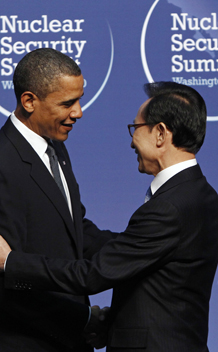U.S.-South Korean Nuclear Relationship: After Fukushima
More on:

I was a last-minute substitute speaker this week on the U.S.-South Korean nuclear relationship at the Carnegie Endowment’s 2011 Nuclear Policy Conference. (A podcast of the event is available here.) The focus of our panel on “U.S. Nuclear Cooperation: How and With Whom?” was on issues surrounding a new U.S.-ROK nuclear cooperation agreement to replace the current agreement that expires in 2014, and featured an excellent review by State’s Richard Stratford of nuclear cooperation agreements the United States will be negotiating with at least 17 countries by 2014.
The main focus of my presentation was on the challenges and pressures Korea poses as it negotiates a revised nuclear cooperation agreement with the United States in terms of its own perceived needs as a new exporter of nuclear plants. U.S. non-proliferation policies are in apparent conflict with the aspirations of the Korean industry to provide the full range of services, including enrichment and reprocessing, so as to maintain international competitiveness in this sector. This aspiration is also at odds with a Congressional desire to tighten restrictions contained in U.S. nuclear cooperation agreements with other countries, and raises some interesting questions about how long it is possible for the United States to sustain its role in shaping the parameters for nuclear activity in other states through its web of nuclear cooperation agreements. Fred McGoldrick last year provided an in-depth analysis of these challenges in a paper available here.
One positive step in dealing with these issues will be to promote greater responsibility among Koreans for safeguarding the nonproliferation regime, including the strengthening of Korean capacities and contributions to nonproliferation in proportion to the benefits Korea expects to gain as a nuclear plant exporter. In this respect, South Korean preparations to host the 2012 Nuclear Security Summit will stretch Korean bureaucrats precisely because the bulk of expertise on nuclear issues in South Korea is attracted to the industry side, with a limited set of career options up to now for those Koreans who want to work on nonproliferation. To handle such responsibilities, South Korea’s Ministry of Foreign Affairs and Trade needs to develop its own cadre of career professionals with deep technical expertise on nuclear issues.
One topic we didn’t get to in the panel is the impact of the Fukushima nuclear disaster on attitudes in South Korea. Despite some jittery reporting in the South Korean media and a nationwide order to conduct safety checks of South Korean reactors, I found surprisingly little urgency regarding these issues among foreign policy specialists with whom I spoke in Seoul. Liz Economy recently pointed out South Korea’s vulnerability to fallout from Chinese reactors, and South Korean media has reported that if South Korea plans for expansion from the current 21 plants to 34 plants by 2024, South Korea will have the greatest density of nuclear reactors to population anywhere in the world. The events in Japan should stimulate a more active nuclear policy debate in South Korea.
I would like to suggest two issues for starters. First, the Japanese disaster and response should catalyze a review of South Korea’s nuclear regulatory structure, in which the South Korean equivalent of the Nuclear Regulatory Commission reports to the Ministry of Education, Science, and Technology rather than having a more autonomous role. In South Korean society, where there is already a web of tight personal connections in the nuclear field among academia, government, and business, the need for a more independent nuclear regulator is critical. Second, the Fukushima disaster has highlighted the vulnerability of pools as a location for long-term interim spent fuel storage, suggesting the need to move more quickly toward expanding dry cask storage facilities, a move that might also expand South Korean spent fuel storage capacity, which is projected to reach capacity by 2016. This does not solve South Korea’s spent fuel problem, but it would presumably make interim spent fuel storage safer while meeting South Korea’s immediate need for expanded storage capacity.
More on:
 Online Store
Online Store